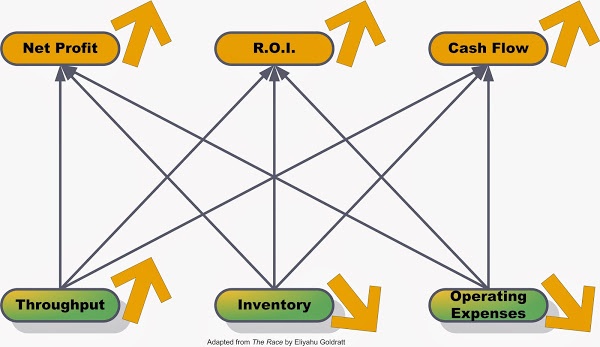In part one, we discussed how entrepreneurial executives and managers, who started out with a strong focus on innovation and meeting a specific (segmented) market’s need in a unique way, frequently lose focus as the demands of their growing enterprise appear to diversify.

Generally, entrepreneurs are successful because their vision is so very clear: in their minds they have worked out a very simple equation that links their day-to-day operational actions to the production of profits. When the organization grows—when more and more functions and departments become involved—these once well-focused managers lose their simplicity.
It is complexity, and the assumption that complex problems require complex solutions, that tend to keep successful entrepreneurial firms from readily leaping the chasm to become successful enterprise operations.
The Simple Entrepreneurial Equations for Profit and ROI
Although a great many entrepreneurs could not succinctly articulate the simple equation that underlies their decision-making, it can generally be reduced to this:

Where:
- delta-P = change in Profit
- delta-T = change in Throughput
- delta-OE = change in Operating Expenses
and, we further define Throughput as Revenue less TVC (Truly Variable Costs)
When an entrepreneur first thinks about starting a business, he (or, she) thinks:
“How much revenue can I produce this this product or service, and what will my truly variable expenses (usually just raw materials and outside services) to produce this revenue? That will be my profit—after subtracting any overhead I rack-up (i.e., operating expenses).”
This clear, simple thinking drives every action (e.g., operational decision).
The clarity of this thinking is predicated on such utter simplicity that it is most frequently innate—that is to say, the entrepreneurial executive can sometimes not even articulate, as a calculation, the strategy driving operational decision.
The Loss of Inherent Simplicity Leads to Loss of Focus
Unfortunately, when the entrepreneur’s organization starts to increase in complexity—that is, when departments and functions begin to proliferate—the executives too frequently fall into the trap of believing (as stated above) that complex situations require complex solutions.
THE LIE: COMPLEX PROBLEMS REQUIRE COMPLEX SOLUTIONS
Two developments over the last several decades have clearly demonstrated that this assumption is a lie.
First, the evolution of the Toyota Production System (TPS) demonstrated that complex problems—in general, much more complex than those faced by American automobile manufacturers—are best solved using simple methods. Under TPS management, finance and accounting steer clear of managing production. For Toyota’s finance office, the production floor is a “black box.” There are inputs and outputs from the black box, but they never look inside at “efficiencies” or “utilization.” Nevertheless, Toyota’s financial performance generally excels the performance of other firms in the world of automotive manufacturing.
Second, the development of the Theory of Constraints (ToC) by Eliyahu Goldratt has shown repeatedly across a vast array of organizations—from mom-and-pop donut shops to Fortune 500 companies—that inherent simplicity is a primary key to restoring focus and creating not only a sound strategy, but also the tactics necessary for execution.
Restoring Focus Restores Sound Strategy (and Tactics)
When we get involved in helping small to mid-sized businesses become more profitable and successful, we never tell them what to do.
We help them unlock what they already know—what we call “tribal knowledge.” This helps them come to a comprehensive, yet very simple, understanding of how their company and their markets work (or fail to work).
This proven process works for creating a process of ongoing improvement (POOGI) for both internal improvements and can help these firms drive improvement all up and down their supply chains, as well.
In the end, we help them begin to once again link operational actions related to production, inventory (or other investment) and operating expenses to the kinds of outcomes they are really seeking. This, in turn, helps them increase profits, liberate cash and dramatically improve ROI (return on investment).
Frequently, these improvements do not even rely on more or better technologies. In fact, sometime we actual suggest that they reduce their reliance on technologies in order to make things simpler—managing with visual tools rather than computers.
Summary
In short, our experience in working with clients has shown us that the real enemy of ongoing improvement in most firm’s performance is complexity. And, while complexity in the organization, its processes, and its supply chain may be inevitable, complex solutions are not inevitable.
We believe that by moving your organization back toward inherent simplicity, you can help recover focus. And when you have recovered focus, your managers and executives can once again clarify both your strategies and tactics for ongoing improvement.
Let us hear your thoughts on this topic. You may leave your comments below, or feel free to contact us directly, if you prefer.



